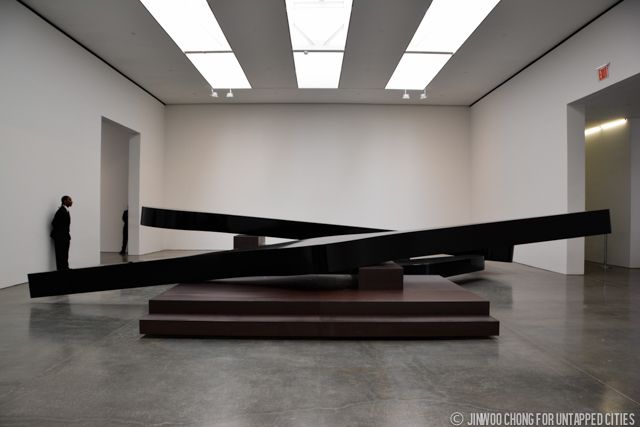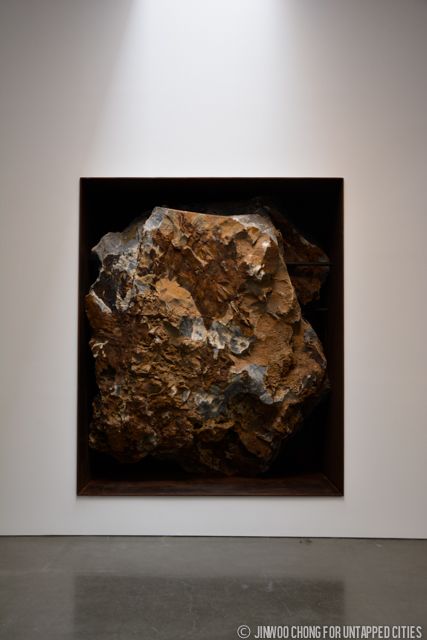Tour Louis Armstrong's House+ More Exclusive Member-Only January Events
Go inside the home of a jazz legend, learn how to make a subway map, spend an evening in a private art collection, and more!


If you ask an art aficionado why they’d pay millions for a Van Gogh (and most of them probably would), the answer might be because Van Gogh was a master Post-Impressionist who defined the form and set a daunting standard. But Van Gogh, as a figure of mystery, just as famous for cutting off his ear as he is for ‘The Starry Night,’ is more than a master painter. His paintings sell for millions also because his tortuous life and peculiar habits made him not just a great painter but a legendary artist.
There is no how-to book for those who aspire to be legendary artists, but Michael Heizer might be onto something. Heizer’s latest show, ‘Altars,’ opened last month at the Gagosian Gallery on West 24th Street in the heart of Chelsea‘s art gallery sector, but many say his magnum opus is yet to come. In fact, it’s been coming for the past 40 years.
That magnum opus is ‘City,’ a land sculpture roughly the size of Washington D.C.’s National Mall at 2 km by .4 km. It sits in a desert valley in Lincoln County, Nevada, where Heizer has been based for the past four decades. It is one of the largest single sculptures ever created, comfortable territory for Heizer, whose previous works include 1969’s ‘Double Negative,’ a 1500-foot long, 50-foot deep trench dug into the sandstone of Moapa Valley in Nevada. Like ‘Double Negative,’ ‘City’ is a defining example of land art, what most critics and writers use to characterize Heizer’s style. Unlike ‘Double Negative,’ ‘City’ will probably never be finished. Heizer is almost 80 years old.
This is one of the only official photographs of ‘City,’ taken by The New York Times. Heizer is notoriously tight-lipped about the piece, and refuses to let anyone see most of the complexes before they are finished. He is currently negotiating with the state of Nevada to buy up the land surrounding ‘City’ to ensure no light or noise pollution should anyone start building right next door.

‘Altar 1’
The Times called him “Art’s Last, Lonely Cowboy.” Though he shows regularly in gallery spaces around the world, Michael Heizer is a recluse, preferring to ship his works across the desert and remain in his Nevada desert. His latest exhibit, ‘Altars,’ occupies the Gagosian and consists of a mixture of granite boulders and steel platforms. The show’s centerpieces, ‘Altars’ 1, 2, and 3, take up most of the space, while the 18-ton ‘Potato Chip’ occupies a wall near the back, opposite the 12-ton ‘Asteroid.’

‘Asteroid’ 12 tons
Like the rest of his body of work, ‘Altars’ is monolithic, silent, and seem to defy physics. ‘Potato Chip,’ especially, hangs completely suspended in a hole in the wall from two steel cables running through its body. Of course, there will always be bigger and heavier boulders and steel structures, but the feeling of viewing them hung up on the walls or displayed in the center of a pristine white gallery is nothing short of unsettling.
Big, heavy things where they most certainly belong seems to be one of Heizer’s specialties. A previous work, ‘Levitated Mass,’ was delivered to Los Angeles County Museum of Art in 2012 and was the subject of a documentary film focused entirely on the work’s transportation from Juniper Valley in California. The work consists of a 320-ton boulder suspended over a manmade trench through which visitors are invited to walk.
‘Levitated Mass’ is still open in California. ‘Altars’ is open in the Gagosian until July 2. As for ‘City,’ no promises.
Next, read about the 40-ton steel cubes sitting in David Zwirner Gallery for ‘Equal’ by renowned architect Richard Serra. Get in touch with the author @jinwoochong.
Subscribe to our newsletter